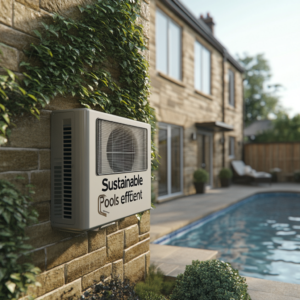Let’s dive into the world of pool heating technology that’s revolutionizing how we enjoy our pools while keeping energy costs down and environmental impact minimal.
Introduction
Swimming pool heat pumps are like your home’s air conditioner running in reverse. Instead of removing heat from a space, they efficiently extract heat from the surrounding air and transfer it to your pool water. This ingenious process uses minimal electricity while providing consistent, reliable heating for your pool.
Understanding Heat Pump Technology
Before we explore the types of heat pumps, let’s understand how they work. Heat pumps use a refrigeration cycle that involves:
– A compressor that pressurizes refrigerant
– An evaporator that captures heat from ambient air
– A condenser that transfers heat to pool water
– An expansion valve that regulates refrigerant flow
The Three Main Types:
- Standard Performance Heat Pumps
These entry-level units are perfect for:
– Moderate climates
– Seasonal pool use
– Smaller residential pools
– Budget-conscious homeowners
They typically achieve a COP (Coefficient of Performance) of 5-6, meaning for every unit of electricity used, they produce 5-6 units of heat.
- High-Performance Heat Pumps
Ideal for:
– Year-round pool use
– Variable climates
– Medium to large residential pools
These units feature:
– Higher COPs (6-8)
– Smart controls
– WiFi connectivity
– Quieter operation
- Commercial Grade Heat Pumps
Designed for:
– Large commercial pools
– Aquatic centers
– Resort facilities
Features include:
– Highest COPs (7-10)
– Multiple unit synchronization
– Advanced monitoring
– Industrial-grade components
Real-World Examples:
Example 1: The Thompson Family Pool
Location: San Diego, California
Challenge: High monthly gas heating bills ($400+)
Solution: Installed 110,000 BTU high-performance heat pump
Results:
– Monthly operating costs reduced to $95
– ROI achieved in 2.3 years
– Consistent 82°F water temperature
– 75% reduction in carbon footprint
Example 2: Oceanview Community Center
Location: Miami, Florida
Challenge: Aging gas heaters, rising maintenance costs
Solution: Multiple commercial-grade heat pumps in parallel
Results:
– 65% reduction in operating costs
– Improved temperature consistency
– Reduced maintenance needs
– Utility rebate qualification
Key Benefits:
- Energy Efficiency
– Up to 80% more efficient than gas heaters
– Lower monthly operating costs
– Reduced peak energy demand
- Environmental Impact
– No direct carbon emissions
– Lower carbon footprint
– Sustainable heating solution
- Cost Effectiveness
– Lower operating costs
– Longer equipment life
– Available rebates and incentives
Installation Considerations:
– Adequate airflow space
– Proper electrical service
– Professional installation recommended
– Strategic placement for noise management
– Proximity to pool equipment
Maintenance Requirements:
– Regular filter cleaning
– Annual professional inspection
– Water chemistry monitoring
– Coil cleaning as needed
Maximizing Efficiency:
- Use Pool Covers
– Reduce heat loss
– Decrease evaporation
– Lower operating costs
- Optimize Settings
– Program heating schedules
– Set reasonable temperatures
– Use vacation modes
- Regular Maintenance
– Keep filters clean
– Monitor performance
– Address issues promptly
Future Developments
The future of pool heat pump technology is exciting, with emerging trends including:
- Enhanced Efficiency
– Higher COPs through improved components
– Better low-temperature performance
– More efficient refrigerants
- Smart Integration
– Advanced weather prediction
– Home automation compatibility
– Remote diagnostics
– Energy usage optimization
- Hybrid Systems
– Solar-heat pump combinations
– Thermal storage integration
– Variable speed technology
- Environmental Improvements
– Natural refrigerants
– Reduced noise levels
– Smaller footprints
Cost Analysis:
Initial Investment:
– Standard units: $2,000-$4,000
– High-performance: $4,000-$7,000
– Commercial grade: $5,000-$15,000+
– Installation: $500-$2,500
Operating Costs:
– 50-75% less than gas heating
– Typical monthly cost: $50-$150
– Varies with:
* Local electricity rates
* Desired temperature
* Climate conditions
* Pool cover usage
Conclusion
Energy efficient swimming pool heat pumps represent a smart investment for both residential and commercial pool owners. They offer significant advantages in terms of:
– Operating cost reduction
– Environmental responsibility
– Consistent performance
– Long-term reliability
With continued technological advances and increasing focus on energy efficiency, these systems will become even more effective and accessible. Whether you’re building a new pool or upgrading existing equipment, a heat pump solution exists to meet your needs while providing substantial energy savings and environmental benefits.

